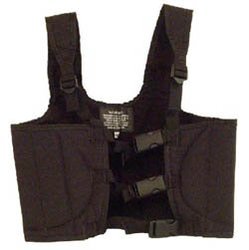The main reason why karts have such good times around tracks and such a high grip is very simple and nobody has mentioned it: karts have a very low CG. This means that the transfer of weight is very low compared with a car. A kart runs at centimeters from the ground.
This is what I call a low CG!

Having such a balanced car gives you very good times: all the three (in turning) or four (in braking) wheels are working almost at their maximum grip. In a car, you brake mainly with the front tyres (and that's true even in cars with such a low CG as F1). When you turn you also get a large lateral weight transfer in a car than in a kart, of course.
Martin Lyell shows how it's done

I won't call nobody's post wrong but if softness of tyres or good suspensions were the key, well, why do not other kind of cars get better times when they have better compounds and... ummm... "sophisticated-er" suspensions?
To be frank, karts actually lack decent suspensions. You have to ponder this: a kart can flex like any spring, sure, but where do you get the damping, guys? A suspension is not merely a thing that moves up and down, it's a thing that actually keeps a constant height when you move over uneven terrain, ehem.
In a kart you do NOT want to have too much grip, in fact. It makes the car to bounce when you accelerate or brake (and I don't know why).
Another weird kart effect (but a fact) is that a wider rear track will give you more grip on certain tracks but most of the time
a wider track will give you less grip. In some cases, narrowing the rear track will give you less understeer. Some times you will get more bite when you have a narrower rear track.
The wider track explanation is false. That's so true that kart setup manuals recommend to AVOID narrowing the rear track as the only way to get more grip

I believe suspension is not that important because karts have low vertical inertia. Simple: the thing weighs less than you (specially when you are as old as I am), so you can actually control with your body a lot of the kart. You wouldn't believe how much you can control the movements with your a$$ and your spine.
A low CG also means that understeer and oversteer are very low,
when you compare them with the ones you get in a racing car. Frankly, that was the hardest thing for me to handle when I grew up and started to race in other classes: the oversteer is larger in the exit when you get serious power and a much larger CG (actually, is way less noticeable in lower kart classes, where you don't have the power).
On a side note (but relevant, when you ponder how low is a kart) you actually
raise the height of the kart to be able to get a better grip
in the wet.
The reason is that you have to raise the inner rear wheel (the darn thing, of course, do not have a differential) because you need to "bite", not to "slalom". On the other hand, while you can control the vertical position of the front axle, most kart rear axles only have two positions... but I digress.
It's not well known, but kart wet weather tyres are larger (slightly larger diameter) to compensate a little for the lack of lateral grip to raise the fourth wheel.
You want more grip in the wet? Get larger tyres (right of the image)

As for the cracked ribs, well, I've rarely crashed against anything in a kart (I've flown over other competitors) and I have them (sore ribs). To achieve this it's perhaps important to avoid tracks with grass (and I recommend that: I hate them and the few kart tracks I've designed have no grass, unlike car tracks I've contributed to) or to be careful and give a wide berth to grass, as I'm used to.
Do not walk on grass

It's not the collisions but the lateral load repetitions what make you sore (and the lack of padding in older seats, btw): that causes sore intercostal (between ribs) muscles, BUT the main cause of injuries, specially in children, is drivers crushing against the steering wheel.
A good rib protector protects you from the steering wheel lacerating your chest AND give you lateral support for your sore intercostal muscles
 This thing is useless in a frontal collision
This thing is useless in a frontal collision

Finally, digressing even more, the grip of a kart varies during the race, in part because of the rubber, in part because of tyre temperatures, in part I don't know. The ideal race is run with a kart that slides a little at the beginning and starts to get grip towards the end. This means the chassis is a little stiffer than you should (stiffer than you use for the best qualifying laps) so you can get a little more grip at the end, just in case someone is interested.









